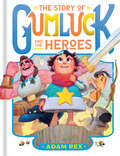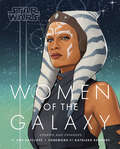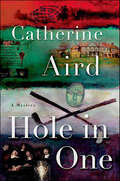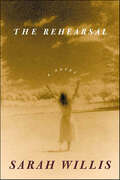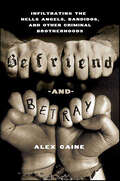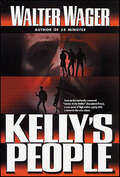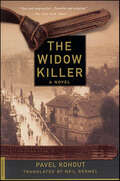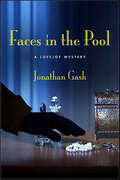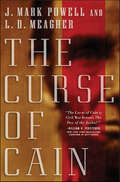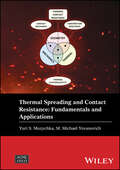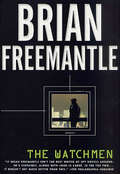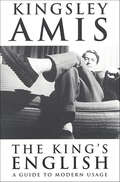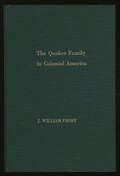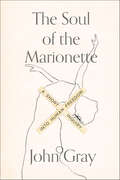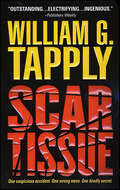- Table View
- List View
All The Things I Say to God: Learning to Pray Anytime, Anywhere
by Tanner OlsonBy popular poet, writer, and speaker Tanner Olson, All the Things I Say to God explores the profound world of prayer and shows children that heartfelt conversations with God can occur anywhere, anytime, and about anything.Abby has been praying with her parents for as long as she can remember. They pray together before meals and before bed, on good days and tough days. Then one day Abby asks a simple question: &“Mom, can I pray to God all by myself?&”Follow Abby on her journey of faith as she discovers how to express her gratitude, ask questions, pray for others, and use silence to communicate with God. Led by her own curiosity, she finds out that you can pray for anything and everything—God&’s love knows no bounds.All the Things I Say to God is for:Children with budding faith who want to know more about how to talk to God.Families who want to start conversations with children about prayer.Churches and ministries with missions to develop the spiritual lives of children.Fans of Tanner Olson and his writing. Young readers will be captivated by this story as they realize that, like Abby, they too can talk to God about anything, all by themselves.
The Story of Gumluck and the Heroes: Book Three
by Adam RexThe story of Gumluck continues! From New York Times bestselling author Adam Rex, this acclaimed, laugh-out-loud series is perfect for young fans of magic, wizardry, and the special alchemy of friendship.A hero fights for what is right! A hero's aim is true! Is the hero of this story like that? I don’t know. He is the kind of person who might turn you into a donut if he's thinking too hard about donuts. His name is Gumluck the Wizard, and he is on a Quest. Along the way he’ll discover singing goblins, unicorn magic, a possible ostrich that breathes definite fire, and three companions who are pretty sure they’re heroes already.With delightful illustrations and a lighthearted mix of fantasy and fairytale elements, this third installment in the chapter book series starring Gumluck the Wizard is a hilarious tale for the reluctant hero in all of us.FIVE STARRED REVIEWS FOR BOOK ONE!"Adorable."—Shelf Awareness, starred review"Readers will fall in love with [Gumluck]."—School Library Journal, starred review "Silly and heartfelt."—Publishers Weekly, starred review"[A] spellbinding read."—Booklist, starred review"Here's a tale to treasure."—Kirkus Reviews, starred review JUST RIGHT FOR NEW READERS: With simple sentences, engaging illustrations, and big themes explored with humor and heart, this series is the perfect choice for newly independent readers who love magical tales.DYNAMIC DUO: This hapless wizard and his lovingly critical friend Helvetica the Raven are memorable characters young readers will love rooting for.FAVORITE AUTHOR: Acclaimed children's book creator Adam Rex is known for his funny and smart stories. The winner of countless state list awards, Rex is the author of beloved books including, On Account of the Gum, Frankenstein Makes a Sandwich, School's First Day of School, and many more.Perfect for:Fans of Adam RexParents and grandparents seeking funny early chapter book seriesTeachers and librarians looking for engaging fantasy and magic books for emerging readersAnyone looking for funny, fantasy chapter booksReaders who enjoy Chris Colfer's A Tale of Magic, the Unicorn Academy series, and Magic Tree House books
Star Wars Dad Jokes: The Best Worst Jokes and Puns from a Galaxy Far, Far Away . . . . (Star Wars)
by Kelly KnoxA charmingly corny book of Star Wars-inspired dad jokes, perfect for geeky fathers, pun lovers, and sci-fi fans of any age.What kind of stories do Wookiee parents tell at bedtime? Hairy tales.Why do the warriors of Mandalore leave their helmets on? It's Mandator-ian.A Jedi Master fights with a lightsaber, but a Jedi father wields the most powerful weapon of all: comedy. Fight the Sith with the knee-slapping, groan-inducing power of these Star Wars-inspired dad jokes or join the dark side and terrorize your family and friends with an army of bad puns. The perfect balance of hokey and wholesome, Star Wars: Dad Jokes is sure to slip through any defenses and have even the most serious of Padawans rolling their eyes.As Master Yoda might say: Laugh, you must!© & ™ 2023 Lucasfilm Ltd.FAMILY FUN: Star Wars is nothing if not a family drama—after all, it boasts one of the most famous dads in movie history. This wholesome, light-hearted book taps into the same family-friendly appeal as Jeffrey Brown’s Vader and Son series, with jokes that will delight parents and Star Wars fans of all ages.UNIVERSAL HUMOR: Like your old man’s trusty baseball cap, dad jokes never go out of style. Jokes and puns continue to be a universal crowd-pleaser. This unique blend of corny and groan-inducing humor is guaranteed to make anyone laugh or, at the very least, shake their head in intergalactic wonder.STAR WARS GIFTS: Star Wars is the fandom that never sleeps. With frequent releases on Disney+ and a full calendar of social media holidays, including the annual "May the 4th Be With You" and "I am Your Father’s Day" celebrations, you don’t have to travel to a galaxy far, far away to find the perfect gifting moment for a Star Wars fan in your life.Perfect for:Fans of Star Wars movies, books, and giftsJokesters and pun loversFather's Day gifts for dads, granddads, uncles, and parental figuresBaby shower or new baby gift
Star Wars Women of the Galaxy Updated and Expanded (Star Wars)
by Amy RatcliffeNow in paperback, fully revised and updated with characters from Disney+ shows including The Mandalorian, Ahsoka, and The Acolyte, as well as The High Republic, Jedi: Fallen Order, and more, this is the essential celebration of the powerful female characters of Star Wars.They are heroes and villains, Sith and Jedi, senators and scoundrels, mothers, mercenaries, artists, and pilots. The women of the Star Wars galaxy drive its stories and saga forward at every level. This beautifully illustrated, fully authorized book profiles fascinating Star Wars women from across films, fiction, comics, animation, and games. Each character is explored through key story beats, fresh insights, and behind-the-scenes details by author Amy Ratcliffe. Also showcasing more than 130 illustrations by a dynamic range of female and non-binary artists, here is an inspiring celebration of the Star Wars characters that help create a galaxy far, far away.© & ™ 2024 Lucasfilm Ltd.NEW CHARACTERS, UPDATES THROUGHOUT: This new edition adds 20 new characters and updates the 75 characters included in the hardcover edition, expanding key profiles such as Rey, Leia, and Ahsoka.NEW ARTWORK: Each new character is featured in a new full-page illustration by a female or nonbinary artist. Expanded profiles also include new artwork.AN INVITATION FOR EXPLORATION: Delivering character profiles that act as introductions but are also rich with detail and insight, this is a fresh way to dive into Star Wars lore through the lens of characters whose stories may span multiple media, and go deeper into the stories of beloved characters.CHARACTERS FROM ACROSS THE GALAXY AND MEDIA (BOOKS, COMICS, TV, GAMES, FILMS): Leia Organa, Rey, Ahsoka Tano, Fennec Shand, Kay Vess, Jyn Erso, Bo-Katan Kryze, Osha and Mae, Padmé Amidala, Avar Kriss, Maz Kanata, Doctor Aphra, and many more . . .Perfect for:Star Wars fans looking to explore or celebrate the female characters of the galaxyAn entry path for anyone looking for dive deeper into stories of favorite characters in different media, or discover new favorite characters
Star Wars: Galaxy's Edge: Traveler's Guide to Batuu (Star Wars)
by Cole HortonSet your course for the edge of the galaxy to the planet Batuu, where you’ll be immersed in the alluring offerings of a mysterious outpost and thriving port that is a haven for scoundrels, rogues, and smugglers.This is the official in-world guide to Star Wars: Galaxy’s Edge, the themed land at Walt Disney World Resort in Orlando, Florida and the Disneyland Resort in Anaheim, California, where you can live out your own Star Wars story, fly the Millennium Falcon, and explore a remote outpost full of surprises. Upon arrival to Batuu, you will have access to an authentic, in-world environment unlike anything you have ever experienced before! Whether living your adventure in Star Wars: Galaxy’s Edge or simply enjoying intergalactic armchair travel, immerse yourself in the pages of this one-of-a-kind Star Wars book to explore:Full-color photos, illustrations, and mapsOriginal content from Lucasfilm Ltd. and Walt Disney ImagineeringBackstories to characters and locations found in Black Spire Outpost This guide is written completely in-world, as if for a visitor from another part of the galaxy looking for recommendations on where to eat, shop, and sightsee while on a trip to this exciting location. An outstanding gift or self-purchase, this in-depth literary and visual companion will delight any Star Wars fan.Perfect for:Star Wars fans and families planning a trip, exploring Batuu, remembering a visit, or looking forward to the next oneDisney and Disney Parks’ fans of all ages
How to Spot a Mermaid
by Jane YolenFrom award-winning and beloved author Jane Yolen, this delightful picture book is a funny and endearing field guide to the unique world of mermaids.Would you like to spot a mermaid? If so, you will need a few supplies and a great deal of patience. As we learn in these informative illustrated pages, mermaids are very shy and do not make friends easily. But if you find a place near the water, sit very still, and are willing to share your Goldfish crackers, you just might be lucky enough to catch a glimpse of one. And who knows . . . there may even be a mermaid, somewhere, hoping to catch a glimpse of you, too! Mermaid fans and science-minded young readers alike will love the step-by-step guidance in How to Spot a Mermaid, a clever how-to book that celebrates the magic in the world around us and helps us to let our imaginations run wild and swim the line between reality and fiction.FOR IMAGINATIVE EXPLORERS: Binoculars, map, pad, and pen—check. The main character who leads the way on this mermaid search is an engaged young scientist doing exciting fieldwork. She is at the ready for real-world observational science with all the tools she needs—including a sense of curiosity! ENVIRONMENTAL BOOK FOR KIDS: Preservation of our wilderness—and our waterways in particular—is essential, and this book makes a great, upbeat starting point for discussions of the importance and wonder of our world's natural habitats and ecosystems. GORGEOUS UNDERWATER WORLD: This captivating marine life book illuminates the amazing biodiversity and wonder of our world's waterways by telling the story of one curious kid's search for an ever-elusive mermaid. Perfect for: Young readers who love mermaid tales and nature books Parents and grandparents looking for books that spark imagination and curiosity Educators looking for books that model fieldwork, observational science, and STEM themes in a fun way Fans of Jane Yolen books, including the How Do Dinosaurs series, Owl Moon, and What To Do With a Box Fans of books illustrated by Sally Deng, including Warrior Princess: The Story of Khutulun and Jella Lepman and Her Library of Dreams Readers who love How to Catch a Mermaid, The World of Emily Windsnap, and The Little Mermaid Stories
Good Movies as Old Books: Films Reimagined as Vintage Book Covers
by Matt StevensImagine your favorite movies as vintage books! This clever collection features iconic films, cult classics, and box office hits brilliantly designed to look like original book covers—a delight for film fanatics and bibliophiles alike.A good book cover is evocative, emotional, and revealing. It lures readers in and invites them to begin a journey with just a hint of the story that is about to unfold. They are true works of art. Though many great movies are based on books, many more are not. Good Movies as Old Books features more than 200 beloved films reimagined as book covers for the first time, giving readers the distinct pleasure of seeing a favorite film transformed into cover art. Through masterful design, art, and typography, graphic designer Matt Stevens has created original vintage-style covers across film genres and eras of book design. From Braveheart to Parasite, Do the Right Thing to Top Gun, this page-turning assortment of box office hits, acclaimed indies, golden era gems, and cult classics will inspire you to discover new favorites or rethink the films you've seen a thousand times. A whole new way to celebrate the movies we love, this is the perfect gift for bibliophiles and cinephiles.BOOKISH FUN MEETS FILM FANDOM: This art book sits directly in the center of the Venn diagram of book and movie love. It's a fun and fresh appreciation of books and cinema, perfect for both avid readers and movie fanatics. ORIGINAL COLLECTIBLE ART: Matt Stevens is a graphic designer and illustrator whose passion for film shines through his unique works of art. He uses a dazzling variety of styles and graphics that perfectly reflect each film’s tone, visuals, and emotion. MOVIE LOVERS GIFT: The ultimate illustrated statement book for anyone with multiple streaming subscriptions, who loves movies based on books, or who regularly goes to the movie theater, this handsome book features a textured cover and eye-catching foil for an extra-special, luxe feel. COMPANION SET OF ART CARDS: Pair this giftable volume with the Good Movies as Old Books: 100 Postcards, a boxed set of 100 images drawn from the book, to create an irresistible set.Perfect for: Cinephiles and bibliophiles Film students and art students Movie buffs and avid readers Gift-giving for Father's Day, Mother's Day, graduation, or birthday Art book collectors and design enthusiasts Fans of Jane Mount's Bibliophile, 1001 Movies You Must See Before You Die, The New York Times Book of Movies, and Accidentally Wes Anderson
Ephemeral City: A People's History of Chicago's Century of Progress World's Fair
by Lindsay FullertonLess celebrated than the 1893 Chicago World’s Fair, the 1933–1934 Century of Progress Exposition brought visitors face-to-face with gleaming American consumerism in the midst of the Great Depression. Lindsay Fullerton draws on a wealth of personal photographs, scrapbooks, oral histories, and writings to illuminate the wildly different experiences of fairgoers against the backdrop of a city steeped in poverty and segregation. The Exposition took place amidst massive changes sparked by expansion of mass media, Franklin Roosevelt’s election, the repeal of Prohibition, and the Great Migration. A diverse cross-section of Chicagoans informs Fullerton’s history of the event in the context of the fast-changing America of the interwar era. These personal accounts tell stories of how attendees interpreted their own experiences while being surrounded by whiz-bang products and full-throated evangelism on the benefits of progress. A colorful people’s history, Ephemeral City takes readers inside the other Chicago World’s Fair and how visitors interacted with a pivotal moment in American history.
In the Global Vanguard: Agrarian Development and the Making of Modern Taiwan (Asia Pacific Modern)
by Prof. James LinA free ebook version of this title is available through Luminos, University of California Press’s Open Access publishing program. Visit www.luminosoa.org to learn more. In just half a century, Taiwan transformed from an agricultural colony into an economic power, spurred by efforts of the authoritarian Republic of China government in land reform, farmers associations, and improved crop varieties. Yet overlooked is how Taiwan brought these practices to the developing world. In the Global Vanguard elucidates the history and impact of the "Taiwan model" of agrarian development by incorporating how Taiwanese experts took the country’s agrarian success and exported it throughout rural communities across Africa and Southeast Asia. Driven by the global Cold War and challenges to the Republic of China’s legitimacy, Taiwanese agricultural technicians and scientists shared their practices, which they claimed were better suited for poor, tropical societies in the developing world. These development missions, James Lin argues, were projected in Taiwan as proof of the ruling government’s modernity and technical prowess and were crucial to how the state sought to hold onto its contested position in the international system and its rule by martial law at home.
Hole in One: A Mystery (Detective Chief Inspector C.D. Sloan)
by Catherine AirdDetective Chief Inspector (D.C.I.) C. D. Sloan works in the deceptively quiet town and county of Calleshire, where for many years he's endured the pressures of his demanding, unreasonable boss and the company of Constable Crosby, Sloan's all too constant but not very helpful sidekick. He's also solved a series of complex murders in Aird's long-running series long praised for it's literate wit, style and charm. In her first new novel in almost two years, Hole in One, a death occurs on the links, a death that is nearly impossible and is, quite improbably, is murder. But improbable is a Calleshire specialty and as far as D. C. I. Sloan is concerned, impossible is merely par for the course.
The Rehearsal: A Novel
by Sarah WillisAn engaging new novel about love, on-stage and offIn the spring of 1971, Will Bartlett, an ambitious director at a small resident theatre, has an idea: he will invite his cast of Steinbeck's Of Mice and Men to his country farm for a month, giving them the opportunity of "becoming" their characters, and enhancing the realistic atmosphere of his next production. Will's family grudgingly agrees to his sudden change of plan, but events and personalities rapidly spiral out of his control. The cast of nine men and one woman is already unevenly balanced, but the situation is made even worse when Melinda--the woman playing the part of Curley's Wife--fails to turn up at the farm as expected. Will's wife, Myra, takes the role, although she has not been on stage since their daughter, Beth, was born. Sixteen-year-old Beth is furious, having already decided that the part should be hers. When the self-obsessed Will remains oblivious to the problems between Myra and Beth, as well as the increasing distance between himself and his wife, Myra finds herself looking at her husband's best friend in a new light. The tension grows between members of Will's family, and the other actors find themselves drawn into a complex tangle of relationships, leading them to question not only how well they know each other, but also how well they know themselves.
Befriend and Betray: Infiltrating the Hells Angels, Bandidos, and Other Criminal Brotherhoods
by Alex CaineThe Hells Angels. The Bandidos. Asian triads. Russian mobsters and corrupt cops. Even the KKK. Just part of a day's work for Alex Caine, an undercover agent who has seen it all. Alex Caine started life as a working-class boy who always thought he'd end up in a blue-collar job. But after a tour in Vietnam and a stretch in prison on marijuana-possession charges, he fell into the cloak-and-dagger world of a contracted agent or "kite": infiltrating criminal groups that cops across North America and around the globe were unable to penetrate themselves. Thanks to his quick-wittedness and his tough but unthreatening demeanor, Caine could fit into whatever unsavory situation he found himself. Over twenty-five years, his assignments ran the gamut from bad-ass bikers to triad toughs. When a job was over, he'd slip away to a new part of the continent or world, where he would assume a new identity and then go back to work on another group of bad guys. Told with page-turning immediacy, Befriend and Betray gives a candid look behind the scenes at some familiar police operations and blows the lid off others that law enforcement would much prefer to keep hidden. And it offers an unvarnished account of the toll such a life takes, one that often left Caine to wonder who he really was, behind those decades of assumed identities. Or whether justice was ever truly served.
Kelly's People
by Walter WagerThe five ace intelligence agents gathered at the secret St. John Institute are the best of the best. The best at tradecraft. The best at weapons handling. The best at analyzing a volatile situation, getting in, getting what they came for, and getting out alive.They are all dead-their old identities perished when they were kidnapped by the secret masters of the institute. Now they have new names and new personal histories. More important, each has received a life-saving organ transplant. And something else-twice a day, each is given an injection of a mysterious golden serum. They are no longer ordinary human beings. Their minds are linked in a bond that grows stronger with time. Their leader is known as Denny Monroe. He doesn't trust anyone associated with the St. John Institute-especially not Charlotte Willson, who oversees the transplant project. Since the five agents are already dead, Monroe figures they're seen as expendable-and he's going to do whatever is necessary to protect himself and his four colleagues. Half a world away, a Russian general, desperate to escape his country's failing economy and crumbling military, sells five small atomic bombs-suitcase nukes-to an international terrorist. He's paid a staggering sum that allows him to ignore the death and destruction the bombs will inevitably cause. But General Temkov can't quite sleep peacefully at night. His best spy has vanished in the U.S. under suspicious circumstances. Kidnapping an Americana diplomat in Moscow, Temkov pressures the CIA to reveal the whereabouts of his missing man. But the CIA knows nothing. The first suitcase nuke destroys a small African city-a test of the equipment. Three more bombs are on their way to London, Jerusalem, and Washington, D.C. The CIA is convinced that the missing spy and the missing bombs are somehow connected. But to find out exactly what is going on, they need Denny Monroe and his band of extraordinary telepaths. Monroe has needs of his own-to determine the identity of the mysterious "Kelly's People." Are they his team, or does the St. John Institute guard even more secrets?At the Publisher's request, this title is being sold without Digital Rights Management Software (DRM) applied.
The Widow Killer: A Novel
by Pavel KohoutIn the downward spiral of the Third Reich's final days, a sadistic serial killer is stalking the streets of Prague. The unlikely pair of Jan Morava, a rookie Czech police detective, and Erwin Buback, a Gestapo agent questioning his own loyalty to the Nazi's, set out to stop the murderer. Weaving a delicate tale of human struggle underneath the surface of a thrilling murder story, Kohout has created a memorable work of fiction
Faces in the Pool (Lovejoy Mysteries)
by Jonathan GashIn Jonathan Gash's 24th Lovejoy Mystery, Faces in the Pool, Lovejoy is released from jail on condition he join the elegant Laura Moon's speed-dating agency. A divorced millionairess, she proposes a temporary marriage of convenience to help her hunt down her former husband. Can Lovejoy do what is expected of him without getting killed?"A picaresque tour de farce. If you crave linear plotting, Gash will send you screaming for Tylenol, but nobody dissembles more brilliantly." - Kirkus Reviews
The Curse of Cain
by J. Mark Powell L.D. MeagherOn April 14, 1865 John Wilkes Booth assassinated President Abraham Lincoln at Ford's Theater, or so the history books tell us ... but what if there was a second gunman who actually pulled the trigger?The Curse of CainLike The Day of the Jackal, The Eagle has Landed, and The Key to Rebecca, The Curse of Cain is the cat and mouse story of a ruthless professional assassin hired to kill the Union President and the Confederate agent dispatched by Jefferson Davis to thwart his plan.Like Forsyth's Jackal, Follett's Needle, and Higgins's Devlin, the assassin-Basil Tarleton-is a charming agent of death. Jack Tanner-a Confederate era Jack Ryan, is willing to forego matters of the heart in order to carry out his mission and save the life of the President of an opposing nation.Set in the closing weeks of the Civil War and against the backdrop of the notorious Lincoln conspiracy (and subsequent cover-up) as well as the actual Confederate intelligence network that existed in Washington, D.C. at the time, Powell and Meagher tell a heart-stopping tale of suspense and intrigue. This dangerous mission follows assassin and pursuer, as they close in on their targets in enemy territory where exposure means certain death.The Curse of Cain races to the page-turning climax on that fateful night at Ford's Theater. At the Publisher's request, this title is being sold without Digital Rights Management Software (DRM) applied.
Thermal Spreading and Contact Resistance: Fundamentals and Applications (Wiley-ASME Press Series)
by Yuri S. Muzychka M. Michael YovanovichThermal Spreading and Contact Resistance: Fundamentals and Applications Single source reference on how applying thermal spreading and contact resistance can solve problems across a variety of engineering fields Thermal Spreading and Contact Resistance: Fundamentals and Applications offers comprehensive coverage of the key information that engineers need to know to understand thermal spreading and contact resistance, including numerous predictive models for determining thermal spreading resistance and contact conductance of mechanical joints and interfaces, plus detailed examples throughout the book. Written by two of the leading experts in the field, Thermal Spreading and Contact Resistance: Fundamentals and Applications includes information on: Contact conductance, mass transfer, transport from super-hydrophobic surfaces, droplet/surface phase change problems, and tribology applications such as sliding surfaces and roller bearings Heat transfer in micro-devices and thermal spreaders, orthotropic systems, and multi-source applications for electronics thermal management applications Fundamental principles, thermal spreading in isotropic half-space regions, circular flux tubes and disc spreaders, and rectangular flux channels and compound spreaders Systems with non-uniform sink plane conductance, transient spreading resistance, and contact resistance between both non-conforming and conforming rough surfaces Providing comprehensive coverage of the subject, Thermal Spreading and Contact Resistance: Fundamentals and Applications is an essential resource for mechanical, aerospace, and chemical engineers working on research in the fields of heat transfer, thermal management of electronics, and tribology, as well as thermal engineers and researchers in the field of thermal physics.
The Watchmen
by Brian FreemantleOnly a miracle-and faulty workmanship-prevents a germ-packed warhead from exploding when a terrorist missile slams into the United Nations building in New York. The lettering on the side of the rocket is Russian, which presents the West with its worst nightmare: a direct link between a fanatical U. S. terrorist group and Russian gangsters with access to the germ warfare arsenal of the former Soviet Union.This potentially devastating attack reunites the FBI's Russian expert William Cowley and Moscow's Organized Crime Director Dimitri Danilov. Their task: to penetrate and destroy the unknown group claiming responsibility before they can strike again.And as the Superpowers teeter on the brink of diplomatic meltdown, Cowley and Danilov make another nightmare discovery. The terrorists are being cleverly financed by ultra-sophisticated hackers looting U. S. banks, breaking into law enforcement and Pentagon computers, and keeping themselves always one click ahead of the frantic pursuit. The Watchmen is a spine-chilling chase that strikes at the heart of our fears of terrorism and its prevention.
The Hiawatha: A Novel
by David TreuerAn elegy to the American dream, and to the sometimes tragic experience of the Native Americans who helped to build it, The Hiawatha is both a moving portrait of a family, and a fast-paced, page-turning literary mystery of murder and redemption.Recently widowed, and encouraged by government relocation schemes to move Native Americans off their reservations, Betty takes her four young children from their Ojibwe roots to make a new life in Minneapolis. As Betty struggles to keep her family and her dignity intact, her younger son Lester finds romance on the soon-to-be-demolished train, The Hiawatha, while his older brother Simon secretly protects his mother by taking a dangerous job as a construction worker, scaling the heights of the skyscrapers that, once completed, will never welcome him. Twenty years later, Simon is released from prison for a horrible crime of passion. His return to Minneapolis sets in motion the dramatic, inevitable conclusion to one family's ceaseless fight to survive.David Treuer more than delivers on the promise he displayed in his acclaimed first novel, Little, and confirms his reputation as one of the most talented and original writers of his generation.
The Delighted States
by Adam ThirlwellHaving slept with a prostitute in Egypt, a young French novelist named Gustave Flaubert at last abandons sentimentality and begins to write. He influences the obscure French writer Édouard Dujardin, who is read by James Joyce on the train to Trieste, where he will teach English to the Italian novelist Italo Svevo. Back in Paris, Joyce asks Svevo to deliver a suitcase containing notes for Ulysses, a novel that will be viscerated by the expat Gertrude Stein, whose first published story is based on one by Flaubert.This carousel of influence shows how translation and emigration lead to a new and true history of the novel. We devour novels in translation while believing that style does not translate. But the history of the novel is the history of style. The Delighted States attempts to solve this conundrum while mapping an imaginary country, a country of readers: the Delighted States.This book is a provocation, a box of tricks, a bedside travel book; it is also a work of startling intelligence and originality from one of our finest young writers.
The King's English: A Guide to Modern Usage
by Kingsley AmisA Parthian shot from one of the most important figures in post-war British fiction, The King's English is the late Kingsley Amis's last word on the state of the language. More frolicsome than Fowler's Modern Usage, lighter than the Oxford English Dictionary, and brimming with the strong opinions and razor-sharp wit that made Amis so popular--and so controversial--The King's English is a must for fans and language purists.
Things That Make Us [Sic]: The Society for the Promotion of Good Grammar Takes on Madison Avenue, Hollywood, the White House & the World
by Martha BrockenbroughThis book is for people who experience heartbreak over love notes with subject-verb disagreements...for anyone who's ever considered hanging up the phone on people who pepper their speech with such gems as "irregardless," "expresso," or "disorientated"...and for the earnest souls who wonder if it's "Woe is Me," or "Woe is I," or even "Woe am I." Martha Brockenbrough's Things That Make Us (Sic) is a laugh-out-loud guide to grammar and language, a snarkier American answer to Lynn Truss's runaway success, Eats, Shoots & Leaves. Brockenbrough is the founder of National Grammar Day and SPOGG -- the Society for the Promotion of Good Grammar -- and as serious as she is about proper usage, her voice is funny, irreverent, and never condescending. Things That Make Us (Sic) addresses common language stumbling stones such as evil twins, clichés, jargon, and flab, and offers all the spelling tips, hints, and rules that are fit to print. It's also hugely entertaining, with letters to high-profile language abusers, including David Hasselhoff, George W. Bush, and Canada's Maple Leafs [sic], as well as a letter to --and a reply from -- Her Majesty, the Queen of England. Brockenbrough has written a unique compendium combining letters, pop culture references, handy cheat sheets, rants, and historical references that is as helpful as it is hilarious.
The Quaker Family in Colonial America
by J. William FrostThe Quaker Family in Colonial America is a book by J. William Frost.
The Soul of the Marionette: A Short Inquiry into Human Freedom
by John GrayCompared with that of humans, the life of the marionette looks more like an enviable state of freedomIn his brilliantly enjoyable and freewheeling new book, John Gray draws together the religious, philosophic, and fantastical traditions that question the very idea of human freedom. We flatter ourselves about the nature of free will and yet the most enormous forces—logical, physical, metaphysical—constrain our every action. Many writers and intellectuals have always understood this, but instead of embracing our condition we battle against it, with everyone from world conquerors to modern scientists dreaming of a "human dominion" almost comically at odds with our true state. Filled with wonderful examples and drawing on the widest possible reading (from the Gnostics to Philip K. Dick), The Soul of the Marionette is a stimulating and engaging meditation on everything from cybernetics to the fairground marionettes of the title.
Scar Tissue (The Brady Coyne Mysteries)
by William G. TapplyBrady Coyne is an attorney with a select clientele and a small practice - he handles mostly the boring paperwork such as deeds, wills, and divorces and leaves the more exciting aspects of the legal profession to others. A call from Jacob Gold, an old friend and client, on a cold February day, however, shatters the slow pace of Brady's life. Gold's fifteen year old son Brian and Brian's girlfriend Jenny were involved in a tragic accident. Their car went off the road and into a river - Jenny was DOA and Brian is missing, his body probably swept away by the river's current. With the parents paralyzed by grief, Brady - divorced with two sons of his own - agrees to help as much as he can. But what seems a simple, if tragic, situation quickly becomes complicated. The accident scene makes no sense to Brady, the police chief of this quiet, middle class Boston suburb seems particularly eager to be rid of Brady and then Jacob Gold moves out of his home and disappears. For the sake of his friends and clients, and for their child, Brady must now find out the truth that lurks behind this tragedy - before yet another innocent life is lost.

